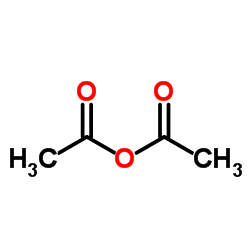2,3-Dimethylphenylisothiocyanate
Modify Date: 2025-09-25 19:37:36

2,3-Dimethylphenylisothiocyanate structure
|
Common Name | 2,3-Dimethylphenylisothiocyanate | ||
|---|---|---|---|---|
| CAS Number | 1539-20-4 | Molecular Weight | 163.23900 | |
| Density | 1.01 g/cm3 | Boiling Point | 128 °C | |
| Molecular Formula | C9H9NS | Melting Point | N/A | |
| MSDS | N/A | Flash Point | 125.8ºC | |
| Name | 2,3-Dimethylphenyl isothiocyanate |
|---|---|
| Synonym | More Synonyms |
| Density | 1.01 g/cm3 |
|---|---|
| Boiling Point | 128 °C |
| Molecular Formula | C9H9NS |
| Molecular Weight | 163.23900 |
| Flash Point | 125.8ºC |
| Exact Mass | 163.04600 |
| PSA | 44.45000 |
| LogP | 3.03770 |
| Vapour Pressure | 0.00655mmHg at 25°C |
| Index of Refraction | 1.554 |
| InChIKey | VASTZUGVKHOFPE-UHFFFAOYSA-N |
| SMILES | Cc1cccc(N=C=S)c1C |
Synonym: Section 2 - COMPOSITION, INFORMATION ON INGREDIENTS
Risk Phrases: 20/21/22 36/37/38 Section 3 - HAZARDS IDENTIFICATION EMERGENCY OVERVIEW
Harmful by inhalation, in contact with skin and if swallowed. Irritating to eyes, respiratory system and skin.Moisture sensitive. Potential Health Effects Eye: Causes eye irritation. Lachrymator (substance which increases the flow of tears). Skin: Causes skin irritation. Harmful if absorbed through the skin. Ingestion: Harmful if swallowed. May cause irritation of the digestive tract. Inhalation: Harmful if inhaled. Causes respiratory tract irritation. Chronic: Not available. Section 4 - FIRST AID MEASURES Eyes: Flush eyes with plenty of water for at least 15 minutes, occasionally lifting the upper and lower eyelids. Get medical aid. Skin: Get medical aid. Flush skin with plenty of water for at least 15 minutes while removing contaminated clothing and shoes. Ingestion: Get medical aid. Wash mouth out with water. Inhalation: Remove from exposure and move to fresh air immediately. If not breathing, give artificial respiration. If breathing is difficult, give oxygen. Get medical aid. Notes to Physician: Section 5 - FIRE FIGHTING MEASURES General Information: As in any fire, wear a self-contained breathing apparatus in pressure-demand, MSHA/NIOSH (approved or equivalent), and full protective gear. Extinguishing Media: Use foam, dry chemical, or carbon dioxide. Section 6 - ACCIDENTAL RELEASE MEASURES General Information: Use proper personal protective equipment as indicated in Section 8. Spills/Leaks: Vacuum or sweep up material and place into a suitable disposal container. Section 7 - HANDLING and STORAGE Handling: Avoid breathing dust, vapor, mist, or gas. Avoid contact with skin and eyes. Use only in a chemical fume hood. Storage: Store in a cool, dry place. Store in a tightly closed container. Store under nitrogen. Section 8 - EXPOSURE CONTROLS, PERSONAL PROTECTION Engineering Controls: Facilities storing or utilizing this material should be equipped with an eyewash facility and a safety shower. Use adequate ventilation to keep airborne concentrations low. Exposure Limits CAS# 1539-20-4: Personal Protective Equipment Eyes: Not available. Skin: Wear appropriate protective gloves to prevent skin exposure. Clothing: Wear appropriate protective clothing to prevent skin exposure. Respirators: Follow the OSHA respirator regulations found in 29 CFR 1910.134 or European Standard EN 149. Use a NIOSH/MSHA or European Standard EN 149 approved respirator if exposure limits are exceeded or if irritation or other symptoms are experienced. Section 9 - PHYSICAL AND CHEMICAL PROPERTIES Physical State: Solid Color: colorless Odor: Not available. pH: Not available. Vapor Pressure: Not available. Viscosity: Not available. Boiling Point: Not available. Freezing/Melting Point: Not available. Autoignition Temperature: Not available. Flash Point: Not available. Explosion Limits, lower: Not available. Explosion Limits, upper: Not available. Decomposition Temperature: Solubility in water: Specific Gravity/Density: Molecular Formula: C9H9NS Molecular Weight: 163 Section 10 - STABILITY AND REACTIVITY Chemical Stability: Not available. Conditions to Avoid: Incompatible materials, exposure to moist air or water. Incompatibilities with Other Materials: Strong oxidizing agents, alcohols, amines. Hazardous Decomposition Products: Nitrogen oxides, carbon monoxide, oxides of sulfur, carbon dioxide, acrid smoke and fumes. Hazardous Polymerization: Has not been reported Section 11 - TOXICOLOGICAL INFORMATION RTECS#: CAS# 1539-20-4 unlisted. LD50/LC50: Not available. Carcinogenicity: 2,3-Dimethylphenyl isothiocyanate - Not listed by ACGIH, IARC, or NTP. Section 12 - ECOLOGICAL INFORMATION Section 13 - DISPOSAL CONSIDERATIONS Dispose of in a manner consistent with federal, state, and local regulations. Section 14 - TRANSPORT INFORMATION IATA Shipping Name: TOXIC SOLID, ORGANIC, N.O.S.* Hazard Class: 6.1 UN Number: 2811 Packing Group: III IMO Shipping Name: TOXIC SOLID, ORGANIC, N.O.S. Hazard Class: 6.1 UN Number: 2811 Packing Group: III RID/ADR Shipping Name: TOXIC SOLID, ORGANIC, N.O.S. Hazard Class: 6.1 UN Number: 2811 Packing group: III Section 15 - REGULATORY INFORMATION European/International Regulations European Labeling in Accordance with EC Directives Hazard Symbols: XN Risk Phrases: R 20/21/22 Harmful by inhalation, in contact with skin and if swallowed. R 36/37/38 Irritating to eyes, respiratory system and skin. Safety Phrases: S 26 In case of contact with eyes, rinse immediately with plenty of water and seek medical advice. S 36/37/39 Wear suitable protective clothing, gloves and eye/face protection. WGK (Water Danger/Protection) CAS# 1539-20-4: No information available. Canada None of the chemicals in this product are listed on the DSL/NDSL list. CAS# 1539-20-4 is not listed on Canada's Ingredient Disclosure List. US FEDERAL TSCA CAS# 1539-20-4 is not listed on the TSCA inventory. It is for research and development use only. SECTION 16 - ADDITIONAL INFORMATION N/A |
| Hazard Codes | Xi: Irritant;C: Corrosive; |
|---|---|
| Risk Phrases | 36 |
| Safety Phrases | 26 |
| HS Code | 2930909090 |
| HS Code | 2930909090 |
|---|---|
| Summary | 2930909090. other organo-sulphur compounds. VAT:17.0%. Tax rebate rate:13.0%. . MFN tariff:6.5%. General tariff:30.0% |
| 1-isothiocyanato-2,3-dimethylbenzene |
| MFCD00041064 |
 CAS#:463-71-8
CAS#:463-71-8 CAS#:87-59-2
CAS#:87-59-2 CAS#:5417-45-8
CAS#:5417-45-8 CAS#:75-15-0
CAS#:75-15-0 CAS#:108654-37-1
CAS#:108654-37-1 CAS#:88101-26-2
CAS#:88101-26-2 CAS#:108-24-7
CAS#:108-24-7 CAS#:55752-58-4
CAS#:55752-58-4